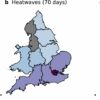For the first time, a study examined perceived neighborhood walkability, physical activity, and obesity indicators on a national level, finding that people who lived in walkable neighborhoods were more likely to be physically active and have lower BMIs—but this association differed among Black, Hispanic, and Asian populations.
Three out of four adults do not meet the recommended levels of physical activity, which the US Centers for Disease Control and Prevention defines as at least 150 minutes of moderate activity or 75 minutes of vigorous activity each week. As obesity and related chronic conditions such as cardiovascular disease, and diabetes continue to rise in the US, a new study led by a Boston University School of Public Health (BUSPH) researcher is examining how neighborhood walkability may influence physical activity and obesity rates.
Published in the journal Obesity, the study examined perceived neighborhood walkability, physical activity, and obesity among adults in the US and found that people in highly walkable neighborhoods were more likely to engage in adequate physical activity, walk near their home, and have a lower body mass index (BMI)—an established indicator of obesity—compared to people in low-walkability neighborhoods. Previous studies have linked walkability with increased physical activity and lower obesity rates, but this study is the first to examine this relationship on a national level.
Notably, the findings revealed that the link between perceived walkability and physical activity differed by race and ethnicity. Black, Hispanic, and Asian residents were less likely to engage in physical activity or walk near their home, despite a greater proportion of residents of color living in high-walkability neighborhoods, compared to White residents.
These racial inequities in physical activity reflect persistent inequitable neighborhood conditions borne from systemic racism and policies that have created barriers for many communities of color to embrace health-protective behaviors, the researchers say.
“In cities and counties across the US, the legacy of racial residential segregation and policies like redlining resulted in poorer built physical activity environments, characterized by decreased walkability, street connectivity, and green space, and increased pollution that disproportionately impact communities of color,” says study lead author Dr. Monica Wang, associate professor of community health sciences at BUSPH. “We’re continuing to see the effects of structural racism on physical activity and obesity risk in the data today.”
For the study, Wang and colleagues utilized demographic and health-related data from a nationally representative survey that gathers information on illness, disability, chronic impairments, health insurance, healthcare access, and health services use in 2020, among US adults ages 18 and older.
They found that adults who live in walkable neighborhoods were 1.5 times more likely to engage in adequate levels of physical activity, and 0.76 times less likely to have obesity, compared to adults living in neighborhoods with low walkability.
However, the team found that the association between perceived walkability and BMI levels differed among certain racial/ethnic groups. Among White, Black, Hispanic, and Asian participants, BMI levels decreased as their perception of their neighborhood walkability increased. But among American Indian/Alaska Native and multiracial/other-race adults, BMI levels increased as perceptions of neighborhood walkability increased.
“While individuals may perceive their neighborhoods to be walkable, it may not be safe, desirable, or normative to walk in these communities,” Dr. Wang says. “This is particularly relevant for communities who have been displaced, whether historically by force or through gentrification. This suggests that a combination of approaches—such as improving pedestrian and public transit infrastructure, implementing policies that slow traffic, enhancing park quality, and community programming—are needed to promote walkability and well-being.”
The study’s corresponding author is Marie-Rachelle Narcisse, assistant professor and senior data analyst at the University of Arkansas for Medical Sciences. The senior author is Pearl McElfish, director of research at the University of Arkansas for Medical Sciences-Northwest.
More information:
Monica L. Wang et al, Higher walkability associated with increased physical activity and reduced obesity among United States adults, Obesity (2022). DOI: 10.1002/oby.23634
Citation:
US neighborhood walkability influences physical activity, BMI levels (2023, February 3)



